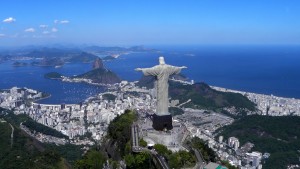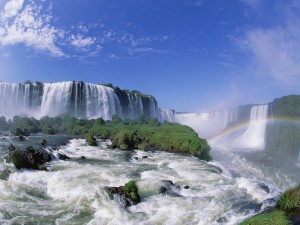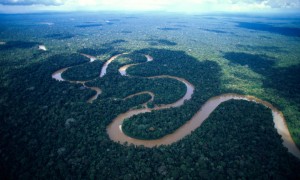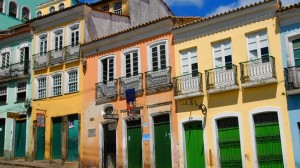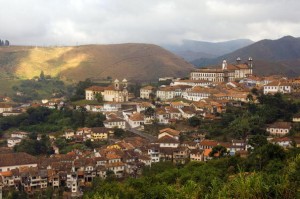Cristo Redentor/Christ the Redeemer (nearest host cities: Rio de Janeiro, Sao Paulo, Belo Horizonte, Curitiba)
On nearly every post-card of Rio de Janeiro is the famous Christ the Redeemer statue sitting on Corcovado’s Mount. The incredible monument and Corcovado’s Railway that leads up to it are a must-see for anyone who visits Rio de Janeiro. The railway, which was inaugurated in 1884 by Brazilian Emperor Dom Pedro II, was considered to be a “real miracle of civil engineering”, as it covered 3,824 meters. [1] Although it originally had a steam engine, the engine was converted to electric machines in 1910 and later used to transport the large pieces of the statue. Construction of the monument, the largest Art Deco statue in the world, began in 1922 and the statue was inaugurated on October 12, 1931. [2] Standing 38 meters tall, the statue serves as a symbol of faith and happiness of the native Rio de Janeiro people (carioca people). It was chosen out of twenty-one monuments from the entire globe as one of the New Seven Wonders of the World. In 2006, to honor the statue’s 75th anniversary, a chapel, at the feet of the statue, was consecrated to Our Lady of Aparecida, the patron saint of Brazil. Tickets are R$46 or approximately $20.
Sugarloaf Mountain/Pão de Açúcar (nearest host cities: Rio de Janeiro, Sao Paulo, Belo Horizonte, Curitiba)
At the foot of the Sugarloaf Mountain, Estácio de Sá founded “the wonderful city” of Rio de Janeiro on March 1, 1565. With the creation of its aerial tramway in 1912, Sugarloaf Mountain helped put Brazil on the map and is often referred to as the “Tourist Jewel of the Wonderful City.” [3] The mountain features a tourist complex and park. At its peak, hikers can watch the Guanabara Bay become the Atlantic Ocean. To the west, Christ the Redeemer is lit up and serves as a spectacular panorama. Although the mountain has little vegetation on the slopes, it features some species that are extinct elsewhere in Brazil. The cable car that connects the city with the park was the brainchild of Augusto Ferreria Ramos, a Brazilian engineer, and businessmen Manuel Antonio Galvão and Commander Fridolino Cardoso. The Portuguese name of the mountain, Pão de Açúcar, allegedly comes from the process of boiling and reducing juice from sugar cane that was then formed into a “cone-shaped clay mold…that resembled the famous mountain.” [4] The cable car only takes six minutes to climb the mountain and leaves every 20 minutes (between 8:00 AM and 8:20 PM). Crowds tend to be worst mid-morning and mid-afternoon, right after the buses arrive. Tickets are R$53 with reduced fares for children, students and seniors and can be purchased here:
http://www.viator.com/Rio-de-Janeiro-attractions/Sugar-Loaf-Mountain-Pao-de-Acucar/d712-a1332
Iguazú Falls (nearest host cities: Curitiba, Sao Paulo, Porto Alegre)
One of the greatest wonders in nature, Iguazú Falls, is located on the border of Brazil and Argentina and are some of the largest in the world. The Iguazú River forms the boundary between Brazil and Argentina, qualifying it as a of the political and geographical structure of the continent of South America.The falls are 80 m high and span approximately 2,700 m wide with 275 falls. The surrounding vegetation features “over 2,000 species of vascular plant” and rare animals such as the “jaguar, ocelot…giant anteater and Brazilian otter.” [5] The park has been designated as a UNESCO World Heritage site and can be accessed through the town of Foz do Iguaçu (which has its own airport) on the Brazilian side. The falls were officially discovered in 1541 by Spanish conquistador Álvar Núñez Cabeza de Vaca. He did not apply much creativity to the name, which translates to “Big Water”. Be sure to see Devil’s Throat or Gargantua del Diablo which includes “fourteen falls drop[ping] 350 feet with such force that there is always a 100 foot cloud of spray overhead.” [6] Although this spectacle is far away from many of the host cities, it is without a doubt one of the highlights of Brazil off the pitch and should not be missed. Price varies by transportation and tours (which are available from the base of the park). It is generally recommended to allot two days to complete the trails and walks.
Amazon River (nearest host city: Manaus)
For the travelers that will be visiting Manaus (the most remote of the host cities), the Amazon River is a must see. Known as Solimões in this part of Brazil, the Amazon River is an essential part of the culture and heritage of Manaus. The river measures an incredible 4,000 miles and competes with the Nile River for longest river in the world (the measurements change). While visiting the river, one can observe the 3,000 different fish species indigenous to the area (and maybe even discover a new one!). [7] Extreme species occupy this eco-system, including bull sharks. To best see the meeting of the Rio Negro and Solimões, take a floatplane flight. Prices will vary by transportation (floatplane or boat) and number of days visiting. Here is a recommended tour guide: http://amazonecoadventures.com.
Salvador and Salvador Beaches (nearest host cities: Salvador, Recife, Natal)
Both a colonial town with a rich history and a host city itself, Salvador provides visitors with stunning beaches and plenty of activities. Salvador was the first urban area to be settled by the Portuguese during their colonization of Brazil and has grown to become the country’s third most populous city. The city became a hub for slave trade in South America and “grew under deep influence of Portuguese, Afro-descendents and indigenous alike: a situation that contributed to the cultural richness that typifies the city today.” [8] African heritage has been maintained in a way only matched by actual African countries. Be sure to visit the colorful churches and colonial buildings (now a World Heritage Site by UNESCO) and learn capoeira, a Brazilian martial art and dance created by the African slaves. End your day by spending time on Salvador’s beautiful beaches, which are ideal for swimming, diving and sailing. However, beware of the congested transportation system.
Ouro Preto (nearest host cities: Belo Horizonte, Rio de Janeiro, Sao Paulo, Brasilia)
Founded during the 17th century and a critical center for the 18th century gold rush, Ouro Preto (“Black Gold”) is an incredibly well preserved colonial mining town near many of the host cities. Originally known as Vila Rica (“Rich Town”), the city was significant in Brazilian history for Inconfidência Mineira, the first attempted uprising against Portuguese colonial rule. [9] Ouro Preto is now a World Heritage Site by UNESCO and is located in the Serra do Espinhaço mountains. The city is home to very carefully preserved Portuguese baroque colonial architecture and features churches decorated with gold and sculptured works of Aleijadinho (a famous Brazilian sculptor and architect). [10] Be sure to see Teatro Municipal (“Opera House”), which is the oldest functioning theater in South America, and Praça Tiradentes (“Tiradentes Square”), which is the center of the town.
Run out of things to do? Here are some suggestions: http://www.tripadvisor.com/Tourism-g303389-Ouro_Preto_State_of_Minas_Gerais-Vacations.html
Bibliography
[1] Trem de Corcovado. “History and Curious Facts.” Trem de Corcovado- Historia. Accessed December 3, 2013. http://www.corcovado.com.br/ingles/historia.html.
[2] Murray, Lorraine. “Christ the Redeemer.” In Encyclopaedia Brittanica. Accessed December 3, 2013. http://www.britannica.com/EBchecked/topic/1435544/Christ-the-Redeemer.
[3] Companhia Caminho Aéreo Pão de Açúcar. “History and Curious Facts.” Bondinho. Accessed December 3, 2013. http://www.bondinho.com.br/en/histories-and-curiosities/.
[4] Ribeiro, Patricia.”Sugarloaf Cable Car Guide.” About Brazil Travel. Accessed December 5, 2013. http://gobrazil.about.com/od/riodejaneiro/ss/
sugarloafcablecar.htm.
[5] UNESCO. “Iguazu National Park.” UNESCO World Heritage Centre. Accessed December 3, 2013. http://whc.unesco.org/en/list/303/.
[6] Hamre, Bonnie. “Iguazu Falls.” About South America Travel. Accessed December 3, 2013. http://gosouthamerica.about.com/cs/southamerica/a/IguazuFalls.htm.
[7] Touropia. “10 Top Tourist Attractions in Brazil.” Touropia. Accessed December 5, 2013. http://www.touropia.com/tourist-attractions-in-brazil.
[8] FIFA. “Salvador: A Host City for the 2014 FIFA World Cup Brazil.” In FIFA. Accessed December 5, 2013. http://www.fifa.com/worldcup/destination/cities/city=50071/profile.html.
[9] UNESCO. “Historic Town of Ouro Preto.” UNESCO World Heritage Centre. Accessed December 8, 2013. http://whc.unesco.org/en/list/124.
[10] Ouro Preto E Circuito Do Ouro Convention & Visitors Bureau. “História.” Ouro Preto- Site Oficial de Turismo. Accessed December 8, 2013. http://www.ouropreto.org.br/materia/pag2/template5.php?materia_cidade=Ouro%20Preto.
How to cite this page: “Top Tourist Attractions in Brazil” Written by Rosa Toledo and Vinay Kumar (2013), World Cup 2014, Soccer Politics Blog, Duke University, http://sites.duke.edu/wcwp/world-cup-2014/world-cup-2014-fan-guide/anglophone-version/exploration-away-from-the-pitch/top-tourist-at…ions-in-brazil/ (accessed on (date)).

